Unmanned Minelayers for Ukraine

A strategic mine warfare campaign against Novorossiysk would enable Ukraine to disrupt Russian Black Sea Fleet (BSF) operations and impose significant economic costs on Russia, potentially bringing the war closer to an end.
KEY JUDGMENTS:
▶︎ Ukraine has the capability to develop and deploy unmanned minelaying vehicles by scaling up unmanned surface vehicle (USV) hulls to accommodate modified commercial-off-the-shelf (COTS) mine deployment systems and advanced bottom mines.
▶︎ A fleet of unmanned minelayers would enable Ukraine to mine Novorossiysk Naval Base, the Sheskharis oil harbor, and the approaches to the commercial port of Novorossiysk.
▶︎ Modified COTS minelaying systems could be integrated into scaled-up variants of Ukrainian Magura-V5 or Sea Baby USVs, or U.S./NATO/partner-provided hulls.
▶︎ Advanced bottom mines could be sourced from the U.S. Navy, allied/partner navies, or commercial manufacturers such as Forcit Defence, SH Defence, Rheinmetall, or SAES.
▶︎ A blockade of Novorossiysk Naval Base would disrupt Russian naval operations by locking docked vessels inside the harbor and denying deployed vessels a sanctuary, blunting BSF operational effectiveness and enabling follow-on Ukrainian attacks.
▶︎ Mining the approaches to the commercial port of Novorossiysk would impose significant economic costs on Russia, cutting off imports of goods and raw materials, and exports of oil and grain.
STRATEGIC MINE WARFARE
History has demonstrated how offensive mine warfare can generate significant strategic effects.
-
Operation Starvation, the mining of Japanese ports and waterways during the final months of World War II, resulted in the sinking or damaging of some 670 vessels totaling more than 1,250,000 tons of shipping. Post-war analysis concluded that a strategic mining campaign alone would likely have lead to Japan's surrender, shortening the war in the Pacific.
-
The mining of Haiphong Harbor during the Vietnam War is credited with bringing the conflict closer to an end by forcing the North Vietnamese to the negotiating table.
-
The mining of Wonsan Harbor during the Korean War, and the Iraqi mining of the Persian Gulf during Operation Desert Storm, respectively delayed and prevented amphibious landings by U.S. forces. (Four minesweepers were lost at Wonsan, and mines laid by Iraqi forces would eventually achieve mission kills on the USS Princeton, a 9,800 ton Ticonderoga-class guided missile cruiser, and the USS Tripoli, a 46,000 ton America-class amphibious assault ship.)
Mining Novorossiysk would disrupt an integral link in Russia's commodity and consumer product supply chain.
-
Novorossiysk is one Russia's largest commercial ports by volume, with annual cargo turnover in excess of 100 million tons.
-
Mining the approaches to the commercial port would cut off imports of foodstuffs (over 178,000 tons of fruits and vegetables were imported in the month of February, 2024) and dry goods (coal, mineral fertilizers, timber, metals, cement, and sugar). It would also sever Russian grain exports, and disrupt Russian international trade.
-
Mining the Sheskharis oil harbor would block a major Russian export hub for crude oil and refined products, severing a vital stream of revenue needed to fund Russian military operations.
UKRAINIAN MICRONAVAL ENGINEERING
Ukraine posseses an agile and innovative "micronaval" engineering capability as demonstrated by the design, construction, and deployment of a variety of remotely operated maritime vehicles.
-
Beginning with a successful attack on the port of Sevastopol in October, 2022, Ukraine has now successfully employed several variants of one-way attack (OWA) USVs, holding the BSF at risk, and damaging or sinking numerous Russian vessels, including landing ships and minesweepers, as well as a corvette, frigate, patrol ship, and tug.
-
Most recently, Ukraine unveiled USVs fitted with a multiple launch rocket system (MLRS), and a maritime "FrankenSAM" air defense battery utilizing a repurposed R-73/AA-11 Archer air-to-air missile system, the ostensible role of which is to distract or engage Russian airborne defenses responding to OWA USV attacks.
NOTIONAL MINELAYER SPECS
Ukraine could develop and deploy unmanned minelaying vehicles using scaled-up OWA USVs.
-
The vehicle's hull could be fabricated by scaling up those of either the indigenously produced Magura-V5 (Length: 5.5 m, 18 ft) or Sea Baby (Length: 6 m, 20 ft) USVs.
-
It may also be possible to repurpose the hulls of coastal patrol vessels previously provided by the United States, or to obtain prefabricated hulls via U.S./NATO security assistance.
-
Like the Magura V5 and Sea Baby, the vessel could be armed with a warhead in the event that it is engaged by a surface vessel during the minelaying mission, or for use in a follow-on, post-mission attack operation.
-
In order to remain afloat, the vessel would need to displace a volume of water equal to its lightship weight (i.e. hull, fuel, propulsion system, warhead, sensors) plus the payload weight, or deadweight (mines and mine deployment system). Assuming an estimated lightweight of 2200 lbs (998 kg) and a payload of of 6500 lbs (2948 kg) (e.g. deployment system plus 12 Quickstrike mines @ 500lbs each), the minelayer's minimum dimensions would be 24 x 10 feet (7.3 x 3 meters).
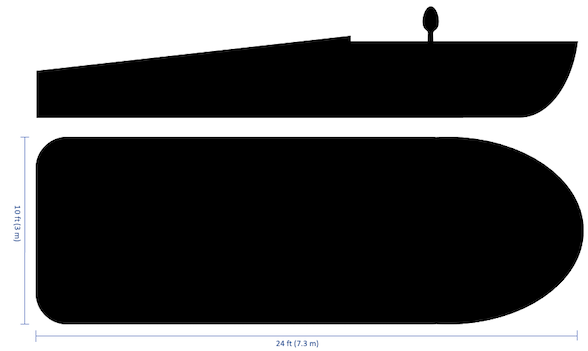
NOTE: Dimensions would vary depending on hull shape and construction, as well as other variables, such as the vehicle's lightweight displacement. For example, a fully loaded minelayer would place a higher demand on the vehicle's propulsion system, requiring additional fuel, or possibly a more powerful (heavier) propulsion system altogether, resulting in a higher lightweight displacement.
If indigenously produced, the vessel's minelaying CONOPS and overall effectiveness would hinge upon Ukrainian resources and production capabilities.
-
Ukrainian hull production or ability to acquire non-indigenous hulls would be key drivers in determining the ultimate dimensions of the minelayer (and, therefore, maximum payload).
-
Payload and fleet size constraints would then drive tradeoffs in minelaying CONOPS. For example, a larger fleet of smaller, faster, but less payload capable minelayers may be more successful than a smaller fleet of larger, slower vessels. This would be further influenced by factors such as Russian defensive capabilities and the availability of escorting USVs to counter those defenses.
-
Minelaying CONOPS would then influence operational planning - specifically, minefield location, density, and total coverage area.
-
Payload limitations could be offset by the use of dummy mines, which would reduce weight while still imposing operational and strategic costs.
NOTIONAL MINELAYING SYSTEM
The minelaying USV would need to be fitted with a mechanical conveyor or gravity assisted minelaying system enabling either remote or preprogrammed operation. Three COTS modular mine deployment systems provide concepts for a notional model:
SUMICO
Forcit Defence
Forcit's SUMICO system is designed to fit inside a 40 foot shipping container, and can be configured to deploy bottom mines of various form factors.
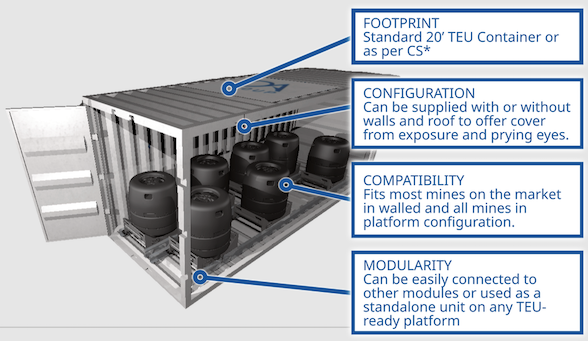
The CUBE
SH Defence
Similar to the Sumico system, the CUBE containerized minelaying system provides a conveyor belt system to deploy mines of varying types.

Mine Rail Deployment System (MRDS)
Rheinmetall
The MRDS is compatible with Rheinmetall/RMW Italia's Murena and Asteria advanced bottom mines.
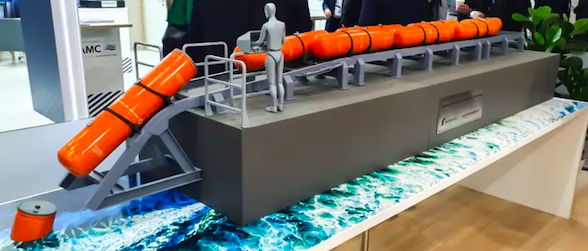
The footprint, weight, high visibility, and aerodynamic drag of a COTS containerized system would make it unsuitable for integration into a medium USV. However, a modified version of such a system could be designed with a low profile, reduced weight, and greater overall stability.
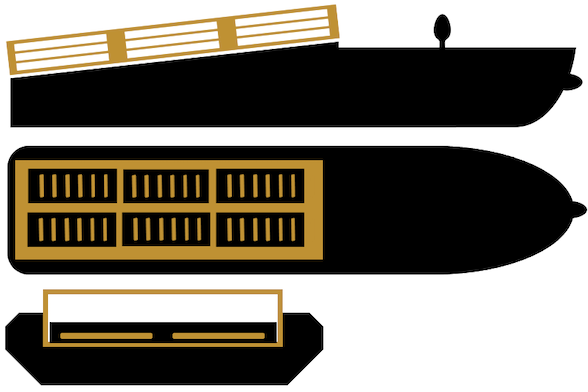
-
A cleated conveyor belt, with differentiated slots, would enable the mines to be deployed off the back of the vessel.

-
The deployment system could be activated remotely via Starlink, enabling the operator to deploy mines at set intervals corresponding with specific waypoints.
WEAPON OPTIONS
With an average depth of less than 100 feet (30 meters), the inner Tsemes Bay could be effectively mined using one or more variants of advanced bottom mines sourced from the United States and/or NATO allies.
Cylindrical mines such as the Quickstrike, Murena, or Asteria could be deployed using a horizontal configuration by rolling off the stern:
QUICKSTRIKE MK-62
U.S. Navy
Weight: 500 lbs
Length: 7.4 ft (2.26 m)
Diameter: 1.3 ft (.38 m)
Depth: 200 ft (61 m)
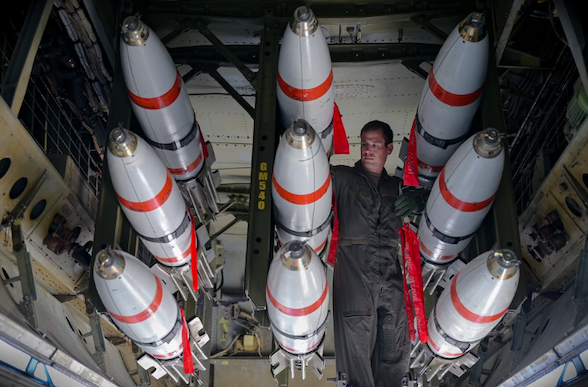
While currently employed by the US Navy as an air-dropped mine, the Mk-62 Quickstrike could be deployed over the side of a vessel. With its tail assembly removed, a payload of approximately twelve Quickstrikes could be loaded onto a USV.
MURENA, ASTERIA
Rheinmetall/RMW Italia
Weight: 1600 lbs (800 kg)
Length: 6.9 ft (2.1 m)
Diameter: 21 in (533 mm)
Depth: 300 meters
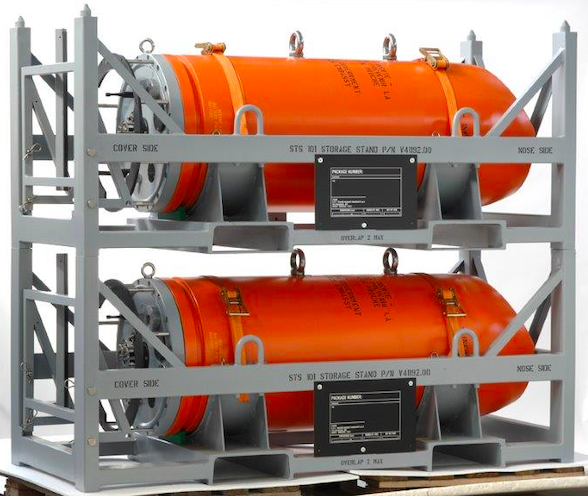
The MURENA (pictured) and ASTERIA are sophisticated multi-influence "smart" bottom mines, equipped with a range of sensing capabilities and counter-countermeasures.
Cylindrical mines could be laid using a remotely controlled, cleated deployment system with gravity assisted roll-off.
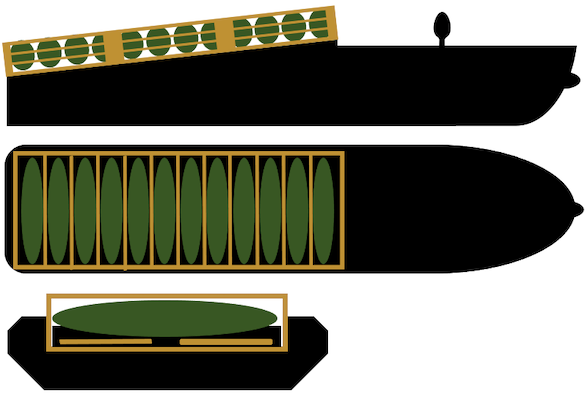
BLOCKER
Forcit Defence (Finland)
Weight: 1653 lbs (750 kg)
Diameter: 3 ft (.9 m) - est.
Depth: 656 ft (200 m)
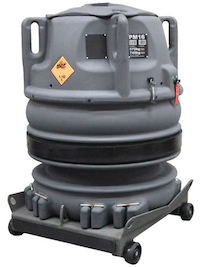
Blockers come equipped with a trolley enabling it to use a gravity assisted roll for stern deployment. Blockers could be deployed using an alternating, double-sided cleated conveyor belt. They have an operational life of two years.
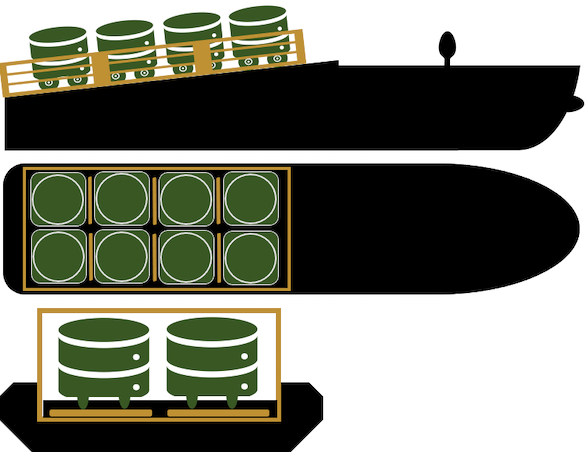
Shallow water anti-invasion mines would be suitable for mining the naval base, as their relatively small (roughly 325 lbs, 147.4 kg) warhead is powerful enough to cause significant damage to armored warships.
MANTA
Rheinmetall/RWM Italia
Weight: 500 lbs (225 kg)
Diameter: 3.3 ft (1 m)
Depth: 300 ft (100 m)
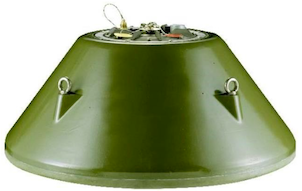
The Manta mine is a shallow water anti-invasion acoustic and magnetic influence mine. A Manta mine laid in 60 feet of water was responsible for a mission kill on the guided missile cruiser USS Princeton during Operation Desert Storm.
MINEA-E Shallow Water Mine
SAES
Weight: ≈ 500 lbs (225 kg)
Diameter: 3.2 feet (973mm)
Depth: ≈ 300 ft (100 m)

The MINEA-E is a shallow water multi-influence mine similar in form and operation to the Manta.
Shallow water anti-invasion mines could also be deployed using an alternating, double-sided cleated conveyor belt.
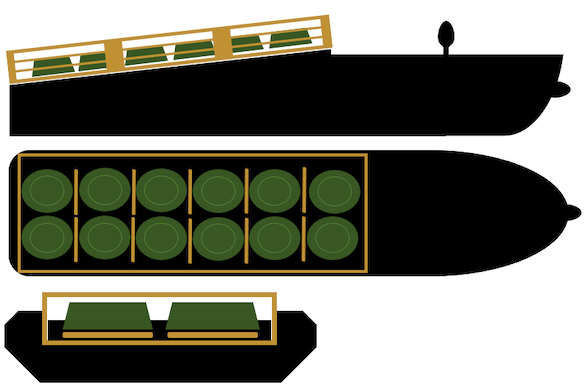
MINELAYING OPERATIONS
Subject to availability, an optimal mission package would consist of:
Air Defense USVs
MLRS, OWA USV Escorts
Minelaying USVs
-
Air defense USVs would defend the minelaying fleet against responding Russian helicopters.
-
MLRS and OWA USVs would defend against responding Russian surface vessels.
The mining package would converge on Novorossiysk before splitting into three units with specific operational areas:
Using waypoint and GNSS navigation, minelayers deploy mines in predetermined patterns to maximize minefield density and coverage area.
ALPHA: Port entrance and inner harbor
BETA: Novorossiysk Naval Base, Sheskharis oil harbor
GAMMA: Tsemes Bay commercial approaches
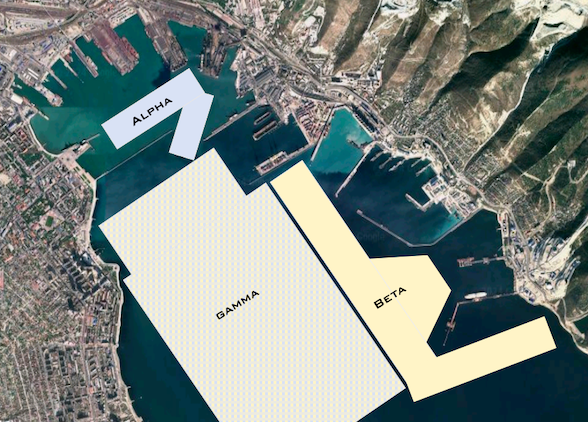
Minefield density and coverage area would depend on a number of factors, including
-
Fleet Size - The availability of materiel and human capital will drive vessel production rate. A smaller fleet of vessels would mean a more tailored, efficient minefield design, focusing on higher density minelaying outside of harbor entrances and within the narrower commercial approaches.
-
Vehicle Loadout - It may be difficult for Ukraine to scale existing hulls, or acquire or repurpose hulls from U.S./allied navies. Smaller vehicles would accommodate smaller mine payloads.
-
Mine Action Radius - Minefield effectiveness will depend on the mine's engagement zone - i.e. the range within which it can detect and meaningfully engage a target. Unclassified estimates suggest that modern bottom mines have an action radius of anywhere from 30 to 100 meters.
-
Attrition Rate - The BSF has adapted to Ukrainian surface drone attacks, employing both air and surface gunnery, and possibly electronic warfare, to detect and engage incoming USVs. Heavily laden minelayers would likely be traveling considerably slower during ingress and deployment operations, making them easy targets for Russian airborne attacks, including attack helicopters and FPV drones.
With payloads deployed, the minelayers have two options:
-
Return to refuel/refit/reload and deploy for a second sortie, or await reseeding operations.
-
Convert to OWA USVs to attack responding Russian surface vessels, or the naval base's security barge/boom system to open a breach for follow-on USV attacks.
COUNTER-COUNTERMEASURES
Russian minesweeping/hunting operations could be significantly disrupted by the timing of the minelaying operation, the advanced logic and sensing of modern bottom mines, as well as follow-on attacks.
-
BSF minesweepers (Alexandrit-class and Natya-class) regularly dock at Novorossiysk Naval Base, and could be blockaded during the opening stage of a minelaying operation.
-
Follow-on OWA USV attacks could target minesweepers and support vessels to delay/disrupt Russian mine clearance operations.
-
Modern sea mines can count passing ships prior to detonation, or distinguish between true acoustic and magnetic signatures and those emulated by minesweeping systems, significantly hampering mine clearance operations.
RISK FACTORS
The ambiguity of international law with respect to offensive mine warfare would spur Russian false narratives and could be leveraged to justify escalation.
-
Moscow could claim that the mining of Novorossiysk is a violation of international law by claiming Article 2 of Hague VIII: Relative to the Laying of Automatic Submarine Contact Mines: "It is forbidden to lay automatic contact mines off the coast and ports of the enemy, with the sole object of intercepting commercial shipping." Article 2 of Hague VIII refers specifically to contact mines, however, not modern, controlled bottom mines. Moreover, Ukrainian mines would be laid solely to strike (i.e. intercept) Russian naval vessels while disrupting, not (necessarily) intercepting, commercial shipping.
-
Given its potential to destabilize the Russian economy, Moscow could view the mining of a major commercial port as an existential threat, prompting an escalation that could widen the war beyond Ukraine, or involve the use of tactical nuclear weapons.
-
Similarly, Moscow could claim that Ukrainian strategic mining carried out using U.S.-provided vessels or weapons represents further "U.S. escalation," prompting Russian counter-escalation or retaliation.
CONCLUSION
A strategic mining campaign against Novorossiysk would have a threefold effect - disrupting BSF operations, breaking an integral link in Russia's commodity and consumer product supply chain, and severing a vital oil and grain export conduit. Ukraine possesses the resources and engineering know-how to develop unmanned minelaying USVs to mine the entrances and approaches to Novorossiysk Naval Base, Sheskharis oil harbor, and the Tsemes Bay commercial port approaches. A Ukrainian strategic mining campaign against Novorossiysk would pose a significant threat to both the Russian Black Sea Fleet and the Russian economy, potentially bringing the conflict closer to an end.

